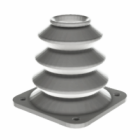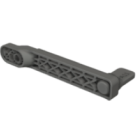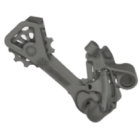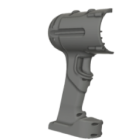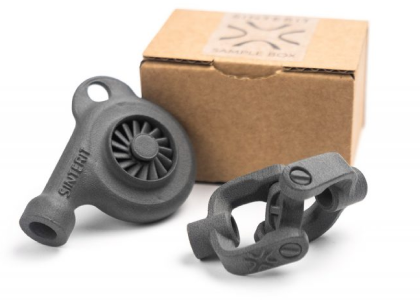Composites 3D printing
Composites 3D printing bridges the gap between lightweight design freedom and structural performance. By reinforcing standard thermoplastics with high-strength fibers, this material class enables the production of parts that are significantly stiffer, stronger, and more resistant to heat or wear than their unfilled counterparts — without sacrificing the geometric complexity that 3D printing allows.
How composites 3D printing works and what materials are used
In additive manufacturing, the term composite refers to any material made by combining a base polymer with reinforcing fibers. These fibers can be either:
- chopped (short) fibers, which are blended into the filament or pellet during material production,
- continuous fibers, which are laid down separately during printing, often along specific toolpaths for maximum strength.
The base polymer is typically an engineering-grade thermoplastic, such as nylon, polycarbonate, or PEKK. The fiber reinforcement — usually carbon fiber, fiberglass, or Kevlar — enhances mechanical and thermal performance without dramatically increasing part weight.
A dedicated composites 3D printer is designed to process these fiber-filled materials reliably. In machines that handle continuous fiber, an additional print head or feeding system is used to lay down reinforcement within or alongside the primary material.
Why use composites in 3D printing and when to choose them
The primary reason to use composite materials is performance. Compared to standard polymers, fiber-reinforced thermoplastics offer:
- higher stiffness and strength at lower weight,
- improved heat resistance, especially in high-load applications,
- dimensional stability, even in large or functional prints,
- superior fatigue and wear resistance, ideal for moving parts or tooling.
These advantages make composites especially valuable in industries where metal may be too heavy, or traditional plastic too weak.
Composites are the right choice when a part demands higher mechanical performance than standard polymers can offer, but doesn’t warrant the cost, weight, or complexity of metal. They’re ideal for functional prototypes, end-use components under moderate load, or lightweight structural parts where stiffness, precision, and durability are required without sacrificing the geometric freedom of 3D printing.
Key applications of composites 3D printing in industry
Composite 3D printing is being adopted in sectors where strength-to-weight ratio is critical, and where part customization or low-volume production is common. Examples include:
sporting goods – frames, protective gear, inserts.Composite 3D printing is being adopted in sectors where strength-to-weight ratio is critical, and where part customization or low-volume production is common. Examples include:
- sporting goods – frames, protective gear, inserts,
- aerospace and drones – brackets, mounts, structural arms,
- automotive – under-the-hood components, jigs, and fixtures,
- industrial tooling – grips, end effectors, custom brackets,
- medical and orthotics – lightweight, customized supports,
- aerospace and drones – brackets, mounts, structural arms,
- automotive – under-the-hood components, jigs, and fixtures,
- industrial tooling – grips, end effectors, custom brackets,
- medical and orthotics – lightweight, customized supports,
How to make moulds using composites 3D printing
One particularly effective use of composite 3D printing is the production of molds for short-run manufacturing and prototyping. By using high-temperature, carbon-fiber-filled nylon materials, it’s possible to create durable, dimensionally stable molds that can handle processes such as vacuum forming, silicone casting, or even moderate-temperature carbon prepreg lay-ups. This approach eliminates the delays and costs typically associated with machined tooling, making it especially attractive for rapid design validation, low-volume production, or one-off geometries. For engineers and designers looking for practical, easy composites solutions, 3D printed molds offer a direct, efficient path from concept to finished part.
Limitations of composites 3D printing and how to overcome them
Despite their advantages, composite materials aren’t ideal for every application. Potential challenges include:
- nozzle wear: chopped fiber is abrasive and requires hardened components,
- printer compatibility: not all machines can handle high-fill or continuous-fiber materials,
- warping or delamination: reinforced polymers can be more sensitive to print orientation and cooling,
- cost: both the materials and the printers tend to be more expensive than basic FDM setups.
Careful part design, slicing strategies, and printer calibration are essential to getting reliable, high-quality results with composite materials.
Summary: is composites 3D printing the right choice for your project?
Composite 3D printing enables the production of strong, lightweight, high-performance parts using fiber-reinforced thermoplastics. Whether you’re replacing aluminum tooling, building functional drone frames, or prototyping jigs for manufacturing, composites offer a unique balance between rigidity and process flexibility. As both hardware and material options continue to mature, composite printing is poised to become a go-to solution for structural applications where polymer alone simply isn’t enough.
Explore also
- Polymers in 3D printing
- 3D printing of metals
- Biocompatible materials for 3D printing
- Raw materials for 3D printing
- Recycled 3D printing filament
- 3D printing flexible
- Filament types for 3D printing
Related categories
 Austria
Austria  Bosnia and Herzegovina
Bosnia and Herzegovina  Bulgaria
Bulgaria  Croatia
Croatia  Czech Republic
Czech Republic  Denmark
Denmark  Estonia
Estonia  Finland
Finland  France
France  Germany
Germany  Greece
Greece  Hungary
Hungary  Ireland
Ireland  Italy
Italy  Latvia
Latvia  Lithuania
Lithuania  Poland
Poland  Portugal
Portugal  Romania
Romania  Slovakia
Slovakia  Slovenia
Slovenia  Spain
Spain  Sweden
Sweden  Switzerland
Switzerland  United Kingdom
United Kingdom  Ukraine
Ukraine  China
China  Hong Kong
Hong Kong  India
India  Israel
Israel  Japan
Japan  Malaysia
Malaysia  Philippines
Philippines  Saudi Arabia
Saudi Arabia  South Korea
South Korea  Taiwan
Taiwan  Thailand
Thailand  Turkey
Turkey  United Arab Emirates
United Arab Emirates  Egypt
Egypt  South Africa
South Africa  Tunisia
Tunisia  Canada
Canada  Mexico
Mexico  United States
United States  Brasil
Brasil  Colombia
Colombia  Australia
Australia  New Zealand
New Zealand 



